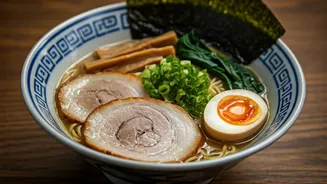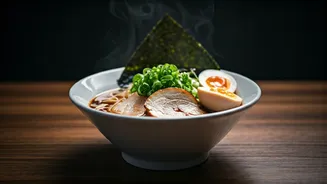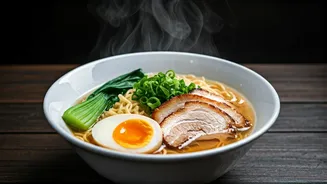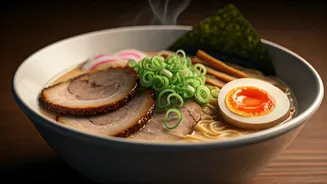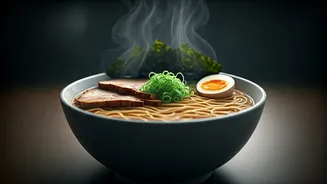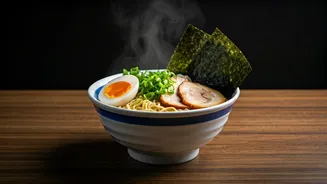Ramen: A Delicious Journey
Ramen, a beloved dish worldwide, has roots firmly planted in Japan, and specifically, Tokyo. It's more than just noodles; it's a symphony of flavors and textures,
meticulously crafted to provide an unforgettable experience. The heart of ramen lies in its broth, a labor of love simmered for hours, extracting maximum flavor from various ingredients. This broth, combined with perfectly cooked noodles, tender meat, and carefully chosen toppings, makes ramen a dish that encapsulates culinary artistry. The essence of ramen lies in its versatility. It can range from light and delicate to rich and intensely savory, appealing to a wide array of palates. Each bowl showcases the chef's expertise and creativity, resulting in a unique and delightful experience. Whether you're a seasoned ramen enthusiast or a curious newcomer, exploring the world of Tokyo ramen opens a door to culinary exploration and a deeper appreciation for the craft.
The Broth: Flavor's Foundation
The broth is the very soul of the ramen experience, and its quality greatly determines the overall appeal of a ramen bowl. The preparation process of ramen broth is often long and involved, requiring careful ingredient selection and simmering over an extended period. Generally, these broths are classified by the key ingredients and cooking methods employed. Popular ramen broth types include tonkotsu, made from pork bones, which results in a rich and creamy broth; shoyu, which is soy sauce based and offers a savory and umami-rich flavor profile; shio, a salt-based broth that highlights the fresh flavors of the other ingredients; and miso, which is made using fermented soybean paste, adding a subtle sweetness and depth. The quality of the broth is all-important, as each component must be in balance. From the first sip to the last drop, the broth provides an immersive flavor profile, making it the most important part of the entire ramen experience.
Noodles: The Perfect Pairing
The noodles are another crucial element of a great ramen bowl, and the type of noodle used can significantly affect the flavor and texture of the dish. There are many different types of ramen noodles, each of which has a different composition and characteristics. The most common type of ramen noodles is alkaline noodles, which are made with wheat flour, water, and kansui, an alkaline salt solution. This gives the noodles a distinctive chewy texture and a slightly yellow color. The thickness of the noodles varies depending on the type of ramen being prepared. For example, some ramen restaurants use thin noodles, while others use thick noodles. Furthermore, noodles are cooked in hot water just before serving. The cooking time varies, depending on the thickness of the noodles. The noodles should be cooked al dente, so that they have a firm bite. This enables them to capture the broth's flavors and complement the other ingredients in the bowl, creating a perfect synergy between them.
Toppings: Flavor Enhancers
Toppings are an important element in the overall flavor of ramen. They add texture, flavor, and visual appeal to the dish. Common ramen toppings include chashu pork, which is slowly braised pork belly, marinated soft-boiled eggs, dried seaweed (nori), green onions (negi), bamboo shoots (menma), and various vegetables. Chashu pork adds richness and depth to the flavor of the ramen, while the marinated soft-boiled eggs contribute a creamy texture and savory flavor. Dried seaweed adds a salty and umami flavor, while green onions add a fresh and fragrant element. Bamboo shoots provide a slightly sweet and crunchy texture. The variety of toppings in ramen is also a means of expressing creativity and the personal touch of a chef. It allows for an array of flavors and tastes that complement the broth and noodles. Ultimately, the toppings serve to improve the ramen's overall taste, making it a more comprehensive and well-rounded meal.
Styles of Ramen
Ramen has many regional variations, each with its unique characteristics, making the dish a dynamic part of Japanese cuisine. Tonkotsu ramen, originating from the Kyushu region, is famous for its rich, creamy broth made from simmering pork bones for extended periods. Shoyu ramen, the most common type, features a soy sauce-based broth and is popular across Japan, offering a savory and slightly sweet flavor. Shio ramen has a clear, light broth flavored with salt and is a common favorite for its simplicity. Miso ramen is a Hokkaido specialty using fermented soybean paste that creates a robust, umami-filled broth. Tsukemen is another, where the noodles and broth are served separately, with noodles dipped into the broth before eating. Each style provides a unique culinary journey, highlighting regional tastes and culinary innovation. The diversity of styles in ramen shows Japan's creativity and the way it continues to change and adapt the craft of cooking.
Finding Authentic Ramen
Finding authentic ramen is an exciting journey of culinary discovery, and several key factors can help you identify a quality bowl. First, consider the restaurant's reputation and authenticity. Look for restaurants that specialize in ramen and have been around for a long time. Read reviews from trusted sources. Second, pay attention to the ingredients. Authentic ramen restaurants often import ingredients from Japan to create a genuine taste. Third, focus on broth preparation, which is the heart of ramen. The broth is usually simmered for hours, and the use of fresh ingredients is a good sign. Also, consider the noodles. Authentic ramen restaurants generally make their own noodles. And finally, evaluate the overall dining experience. A well-designed atmosphere and friendly service enhance the experience and add to the meal's enjoyment. Through these tips, one can ensure they are enjoying an authentic bowl of ramen that highlights the traditions and flavors of Tokyo.
